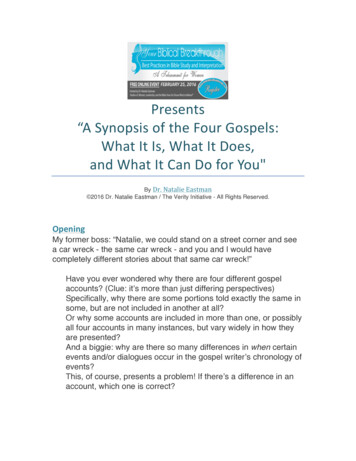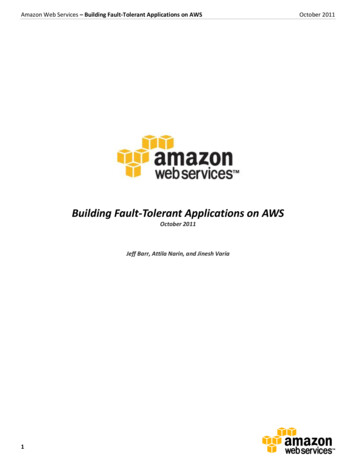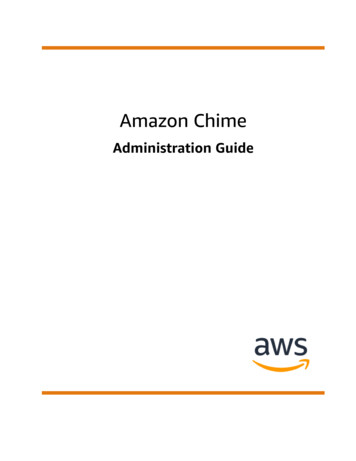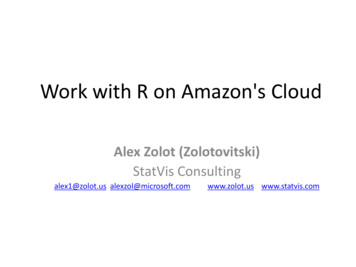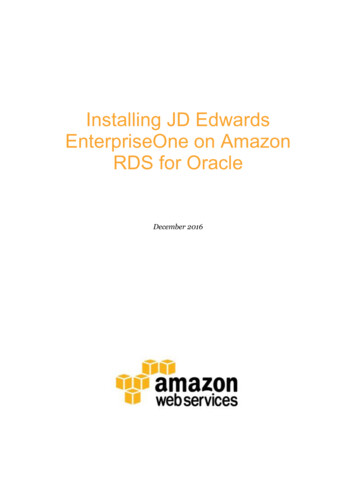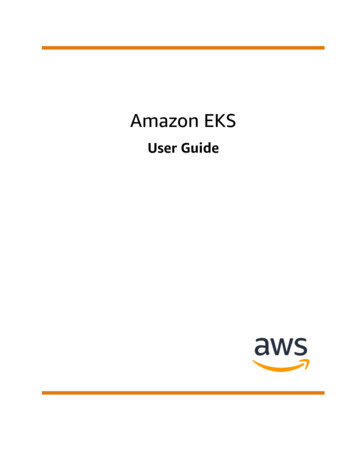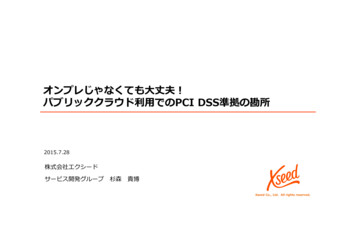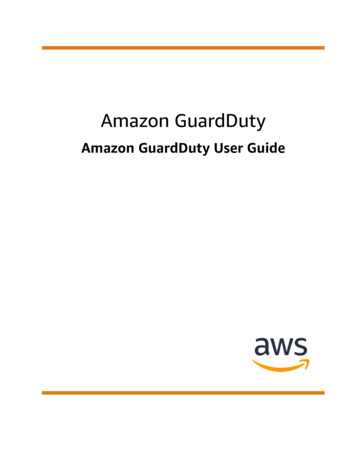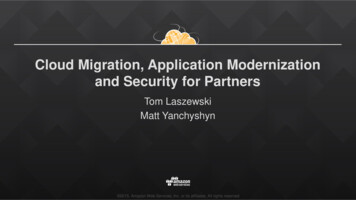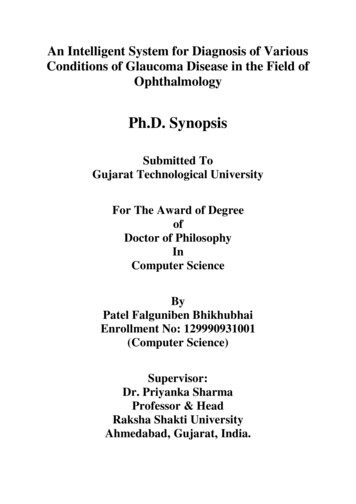
Transcription
An Intelligent System for Diagnosis of VariousConditions of Glaucoma Disease in the Field ofOphthalmologyPh.D. SynopsisSubmitted ToGujarat Technological UniversityFor The Award of DegreeofDoctor of PhilosophyInComputer ScienceByPatel Falguniben BhikhubhaiEnrollment No: 129990931001(Computer Science)Supervisor:Dr. Priyanka SharmaProfessor & HeadRaksha Shakti UniversityAhmedabad, Gujarat, India.
IndexSr. No.IIITopicTitle of the Thesis and AbstractBrief Description on the State of the Art of theResearch topicPage Number12IIIProblem Definition5IVObjective and Scope of Work6VThesis Contribution7VIMethodology of Research, Results / Comparisons8VIIAchievement with respect to Objectives12VIIIConclusion12IXXCopies of papers published and a list of allpublications arising from the ThesisReferences1313
I.Title of the Thesis and Abstract :Title of the Thesis: “An Intelligent System for Diagnosis of VariousConditions of Glaucoma Disease in the Field ofOphthalmology”Abstract:Decision support system in medicine is a peculiar form of clinical data processing coming froma range of clinical as well as atomized systems. However, it is more complicated in medicinethan in other areas, because of medical terms, semantic relations and amount of data. Reachinga full proof diagnosis in Ophthalmology, is never an easy job for a clinician. There are numberof examinations performed using various diagnostic instruments, in order to diagnose theproblem from the symptoms described by the patient. Result of each examination needed to beinferred separately, because of the variation in representations and their significances. Foraccurate diagnosis, the results of number of examinations are to be inferred in a contextualconjunction. This is again a complicated task forming the diagnosis.Glaucoma, an eye diseases is prevailing in aging population. It causes an irreversible loss ofvision. There is a distinct need of Computer aided solutions for diagnosis purposes. [24] Therising concern for the treatment of this disease is increasing looking at the propagation ofglaucoma cases in past few recent years. It is majorly widespread in urban aging population.According to an estimation, 79 million individuals all over the world would be affected byglaucoma by year 2020. [34] [15] Within a decade, the estimation shows a 33% increase in thenumber of people affected by glaucoma. [36] Thus, screening for glaucoma is crucial, owingto the nature, for the early detection and enabling effective treatment in early stages to preventpermanent blindness. [24]According to Glaucoma society of India, glaucoma is the second leading cause of blindness inIndia. The major challenge posed by Indian population is the number of people getting affectedby glaucoma. At present, 12 million people in India are affected by glaucoma which is expectedto increase to 16 million by 2020 [36]. The number of patients per ophthalmologist is around2 to 3 lakhs in India. Thus apart from cost, lack of manpower in terms of skilled techniciansposes major challenge in such scenarios.1
Diagnosis of glaucoma is dependent on various findings such as IOP (if IOP 21 mm Hg [17],it is considered as a suspicious case for glaucoma), optical nerve cupping and visual field loss.Detection and diagnosis of Glaucoma is performed through various tests such as Tonometry,Ophthalmoscopy, Perimetry, OCT, Gonioscopy and Pachymetry. [10]Artificial neural networks are finding many uses in the medical diagnosis application. Artificialneural networks provide a powerful tool to analyze and model complex clinical data for a widerange of medical applications. Most applications of artificial neural networks to medicine areclassification problems; that is, the task is on the basis of the measured features to assign thepatient to one of a small set of classes. [35] An artificial neural network a part of artificialintelligence, with its ability to approximate any nonlinear transformation is a good tool forapproximation and classification problems. [40][25][4] Multilayer perceptron (MLP), a feedforward, back-propagation network, is the most frequently used ANN technique in glaucomaresearch. [37]The primary focus of this research is to develop an intelligent diagnostic system for Glaucomaan eye related disease, from the data obtained through clinician by various examination devicesor equipment used in ophthalmology. These is used as training set to multi-classifier, developedusing hybridization of various techniques of Artificial Intelligence. The classification is doneby a hybrid approach using Artificial Neural Network, Naïve Bayes Algorithms and DecisionTree Algorithms. A design/development of a new technique or algorithm is required for suchdiagnosis and it is tested for its efficacy. Using the algorithms and techniques of NeuralNetwork, Naïve Bayes Algorithm and Decision Tree based classifiers, the proposed hybridtechnique is anticipated to intelligently analyze and perform diagnosis for patient’s visionarypredicaments, thus lessening the intervention of medical practitioners in terms of decisionmaking.II.Brief Description on the State of the Art of the Research topic :The last few decades have seen a proliferation of intelligent systems for diagnosis, advisingand related applications. Intelligent systems for diagnosis have been used in a variety ofdomains: plant disease diagnosis, crop management problem diagnosis, credit evaluation andauthorization, financial evaluation, identification of software and hardware problems andintegrated circuit failures, troubleshooting of electrical, mechanical and electronic equipment,2
medical diagnosis, fault-detection in nuclear power systems, oil exploration, prospecting,seismic studies, etc. Despite the great variety of approaches and technologies used in the designof such systems, they all address the same pattern classification problem: the task of assigninga given input (e.g., a pattern, image, set of observations, etc.) to some category (or class).Diagnosis systems classify the observed symptoms as being caused by some specific problem(diagnosis class) while advising systems perform such a classification and suggest correctiveremedies. [9][12][16][38].The logical thinking of medical practitioner involves a lot of subjective decision making andits complexity makes traditional quantitative approaches of analysis inappropriate. Thecomputer based diagnostic tools and knowledge base certainly helps for early diagnosis ofdiseases. The intelligent decision making systems can appropriately handle both the uncertaintyand imprecision. [41] AI can definitely assist clinicians to make better clinical decisions or itcan replace human judgment in certain functional areas of healthcare. [18] Guided by relevantquestions pertaining to various clinical parameters, a powerful AI techniques can reveal hiddeninformation from the massive quantity of data, which plays a key role in assisting clinicaldecision making.[26][19][11].The application of machine learning models [27] on human disease diagnosis aids medicalexperts based on the symptoms at an early stage, even though some diseases exhibit similarsymptoms. Many intelligent system have been developed for the purpose of enhancing healthcare and provide a better health care facilities, reduce cost and etc. As express by many studies[28][29][1] (such as Mahabala et al., 1992; Manickam and Abidi, 1999; Alexopoulos et al.,1999; Zelic et al., 1999; Ruseckaite, 1999; Bourlas et al., 1999), intelligent system wasdeveloped to assist users (particularly doctors and patients) and provide early diagnosis andprediction to prevent serious illness.[45][39][5]Fujita et al. has deliberated an emerging CAD system for the detection of glaucoma,hypertensive retinopathy and diabetic retinopathy. This system uses retinal fundus images forthe detection of these diseases. [14] Many automated systems for retinal image analysis inorder to correctly classify the patients with Diabetic Retinopathy are proposed. [30] SIVA is asemi-automated system developed by National University of Singapore for analyzing thevascular system of eye. [8] There are some Software packages available, which allowprocessing of data gathered from these systems: ADRES 3.0 is used for the grading of diabeticretinopathy developed by Perumalsamy et al. It has been commercialized and deployed in3
diabetic centers and general physician clinics in India for use. [31] The clinical trials for thediagnosis of several ocular diseases is being run by Singapore Eye Research Institute. It is alsorunning clinical trials for pathological myopia (PM), diabetic retinopathy and age relatedmacular degeneration (AMD), using a uniform set of ophthalmic image reading and analysisprotocols. [42] There are two recent works on ocular disease diagnosis based on clinical data.Liu et al. [23] developed an architecture of automatic glaucoma screening and diagnosis. Thearchitecture is known as (AGLAIA-MII) automatic glaucoma diagnosis through medicalimaging informatics. It provides glaucoma diagnosis by combining patient’s personal data,Digital Fundus Photographs’ imaging information and genome information. Features wereextracted automatically from each data source. Subsequently, these features were passed to amultiple kernel learning (MKL) framework. This MKL generate a final diagnosis as anoutcome. In another work, Zhang et al. [46] proposed a framework of computer-aided diagnosisfor Pathological Myopia (PM). It is based on Biomedical and Image Informatics. Data fromthese heterogeneous data sources contains fundus images, demographic/clinical and geneticdata. The framework proposed by Zhang et al. combined these data to enrich the understandingof Pathological Myopia, it provides a complete information of the risks factors involved andimproves the diagnostic outcomes. A data-driven approach was proposed to exploit the growthof heterogeneous data sources to improve assessment outcomes.One of the pioneer research works on Clinical Decision Support Systems (CDSS), wasdeveloped in late 1970s to assist in the diagnosis of glaucoma. The system is known asCASNET (causal-associational network). [44] In CASNET, clinical data is used. This datacovers symptoms reported by the patient, such as, ‘ocular pain’, ‘decreased visual acuity’. Italso covers various eye examination results, such as, visual acuity, IOP, anterior chamberdepth, angle closure, pupil abnormality and corneal edema. [20] A descriptive model of thedisease process is used in CASNET logical interpretations of clinical findings for glaucomadiagnosis. The model had a semantic net with weighted links representing pathophysiologicalmechanisms. It represented early medical expert systems. The framework of CASNETdescribes the knowledge of expert consultants and simulates various aspects of the cognitiveprocess of clinicians. In 2002, Chan et al. reported the most initial implementation of SupportVector Machines (SVM) for glaucoma diagnosis. [6] The Standard Automated Perimetry(SAP), a common computerized visual field test produced the output of the Clinical data usedin the research. The authors equated the performance of various machine learning algorithmswith SAP output. Multilayer perceptron (MLP), SVM, Linear and Quadratic Discriminant4
Analysis (LDA and QDA), Parzen window, mixture of Gaussian (MOG), and mixture ofgeneralized Gaussian (MGG) were the machine learning algorithms that were included for thestudy. It was witnessed that machine-learning-type classifiers displayed enhanced performanceover the best indices from SAP. Moreover the authors also deliberated upon the benefit of usingfeature selection to additionally improve the classification accuracy with a prospect to diminishtesting time by considerably reducing the number of visual field location measurements. In2011, Bizios et al. carried out a study examining the data fusion methods and techniques forsimple combinations of parameters retrieved from SAP and measurements of the Retina NerveFibre Layer Thickness (RNFLT) obtained from Optical Coherence Tomography (OCT) fordiagnosis of glaucoma using Artificial Neural Networks. [3] The results indicated that thediagnostic precision from a blend of fused SAP and OCT data was much greater than usingeither of the two separately. This was the first every testified study using fused data forglaucoma diagnosis. A new study reconnoitered the association between the central cornealthickness (CCT), Heidelberg Retina Tomography II (HRTII) structural measurements and IOPusing a pioneering non-linear multivariable regression method, for the purpose of outlining therisk factors in future glaucoma advancements. [21] Barella et al. investigated the diagnosticproficiency of machine learning classifiers (MLCs) and random forest (RF) using RNFL andoptic nerve data. [2] The end result was 0.877 of area under the ROC value using RF.III.Problem DefinitionThe research is multidisciplinary in nature, involving computer science as well as medicinedomain. Information was gathered on various fields of medicine where automated diagnosiswas required such as, radiology, cardiology and ophthalmology. The Ophthalmic diseases lackfatality, but have tendency to progress overtime leaving permanent disability-morbidity, thathave more impact on daily life of the patients. [13] In this context, the Indian population ismore vulnerable to these diseases due to their genetic predisposition, changing lifestyle andtimely diagnosis of the disease. As the diseases are chronic and non-treatable at later stage,they impose heavy economic and social burden to over developing economy in the form of lossof working hours and treatment cost.The identified issues in research from literature study are:1. The diagnosis in medicine is more complicated than in other areas because of medicalterms, semantic relations and amount of data involved in process of diagnosis. It dealswith significant amount of analysis though advanced investigating equipment,5
producing minute examination data as well as analysis of such data in the form ofnumeric, bar charts, line charts etc. This requires specially designed intelligent systemfor complex data and analysis process.2. In India, most of the healthcare delivery systems are based on manual record keepingor Electronic Health Record Systems (EHRs) which helps in maintenance of patienthistory. Presently accuracy of diagnosis depends on the human attributes such as, pastexperience and domain specific knowledge, using which, practitioners are concludingtheir diagnosis. Patients are required to consult more than one doctor for secondopinion, which is costly in monetary terms as well as time consumption. An intelligentsystem can very well address such issues.The research was carried out in the area of Artificial Intelligence-Machine Learning, moreparticularly with reference to the suitable Classification and Prediction Algorithms of ArtificialIntelligence-Machine Learning. The research also encompasses the development of newalgorithms/techniques and testing them in the domain of Ophthalmology for diagnosingvarious stages of Glaucoma- an eye disease.IV.Objective and Scope of WorkThe proposed system is intended to support clinicians at various stages in the eye care process,from preventive care through diagnosis, followed by proper treatment and medical advice. Thesystem would be used to seek second opinion for the practitioner and would be able to facilitateremote diagnosis at lower costs, improved efficiency & speed, and reduced doctor’s physicalintervention at the patient’s examination site.The trade-off between prediction power and interpretability is one of the well-known issues inmachine learning. The black box models such as Support Vector Machine (SVM) and deeplearning algorithm show good prediction power. However, it is difficult to understand how themodel gives the prediction result. Therefore, they are not entirely suitable for medical diagnosisbecause clinicians want to know both the prediction and the reason for the prediction. [43]Decision tree models [22] such as C5.0 [32] [33] show good interpretability and poor predictionpower. Logistic Regression and Naïve Bayes are algorithms used for probabilistic classification[7].6
Objectives of the Research:1. To determine the patient wise classification of glaucoma conditions (types).2. To study and analyze various techniques for detection of glaucoma types conditions(types) in patients.3. To identify the most appropriate detection technique for different conditions (types) ofglaucoma.4. To explore and analyze new techniques / algorithms for diagnosing various conditions(types) of glaucoma in patients.5. Devising appropriate techniques / algorithms for testing diagnosis of various conditions(types) of glaucoma and studying the efficacy of these techniques.The goal of this research was to develop an Intelligent System that has strong prediction powerand an equally good results’ interpretability for diagnosis of various stages of glaucoma. Toachieve the goal, an ensemble algorithm was developed for selecting good features fromclinical eye examination data for classification and prediction. To develop the new algorithm,the existing algorithms C5.0, RF, SVM, and k-nearest neighbour (KNN) algorithms, NaïveBayes, Multilayer Perceptron, J48 were tested.V.Thesis ContributionThe research uses artificial intelligence (machine learning) techniques for diagnosis ofGlaucoma. The main contributions of the thesis are:1. A survey of state of the art of the artificial intelligence techniques used for eye diseasediagnosis mainly Glaucoma diagnosis.2. A literature review on classification techniques used for diagnosis of various conditions(types) of Glaucoma.3. Study and analysis of different classification techniques for Glaucoma diagnosis.4. Design and develop hybrid classification techniques to obtain high classificationperformance.7
VI.Methodology of Research, Results / Comparisons1. Methodology of ResearchThis research is multidisciplinary and diagnostic. It is multidisciplinary since it maps somedomains of Computer Science and Ophthalmology which is a branch of medicine. It is alsodiagnostic as it follows case-based method using in depth approaches of various classificationtechniques of computer science to reach basic causal relations. The sample size is also smalland require deep probing data gathering devices used in ophthalmology.The sample size is 163. Out of these 163 samples 107 were used for training set and 56 wereused for testing set.i. Profile of RespondentsDEMOGRAPHIC PROFILE OF PATIENTSAGENo.ofAge GroupsPatients% Patients25-442112.8845-649256.4465-794326.38Above 8074.29Table 1.0: Table showing Demographic Profile of Patients Age GroupsThe data collected from the patients was categorized into 4 classes based on the Age structuresuggested by the Census 2011 of India.In the patient’s data 12.88% patients were found to be in the ages between 25 years and 44years. 56.44% patients were found to be in the ages between 45 years and 64 years. 26.38%patients were found to be in the ages between 65 years and 79 years whereas 4.29% patientswere above the age of 80 years.8
GENDERGenderNos.%Male10665.03Female5734.97Table 2.0: Table showing Demographic Profile of Patients Gender GroupsThe data collected from patients was categorized into 2 classes based on the Age structuresuggested by the Census 2011 of India.From the collected data, 65.03% patients were Males and 34.97% were Females.ii. Flow of ResearchPatient Data InputModelConstruction ClassificationModelModelLearningDiagnosis OutputAccuracyComparisonThe Dataset used in this research was obtained from practitioner. The data was validated bythe practitioner. It was normalized and standardized. The training set was used for constructionof a classification model. The model was constructed using 10-fold cross validation. The modellearning was carried out using training set. It was used for classification of the testing set. Themodel provided diagnosis of various conditions (types) of glaucoma disease. The accuracyobtained by the model was compared with other models found in the literature review.9
iii. Configuration of ClassifierThe Classifier for diagnosis of various conditions of Glaucoma, was using ensemble of morethan one classifiers. The configuration of Multi-classifier was Parallel Configuration forcombining classifiers. [48] The classifiers used for Multi-classifier were Neural Network classifier,Decision Tree classifier and Naïve Bayes classifier. These classifiers were further optimized to improveaccuracy. The decision logic, which provides final classification from different classifiers was alsooptimized to nullify the bias of individual classifiers.Fig. 1.0 Multi-classifier model10
2. Results/ComparisonThe ensemble classifier showed improved accuracy compared to individual classifier. Theensemble classifier accuracy was compared with other classifiers’ accuracy found in literaturereview. The accuracy of Multi-classifier was 98.77%, which was higher than the accuracygiven in Table 3.0.Accuracy of different techniques for Glaucoma diagnosisSr. No.AuthorParametersClassifierMeasuring Parameter1Nagaraj et alVisual Bizioz et alOptic Nerve HeadANNSensitivity-93%Specificity-94%3Nayak et alOptic Disc, BloodANNVesselSensitivity-100%Specificity-80%4Hung et alRNFL ThicknessANNArea ROC-0.975Chauhan et alCDR, Accuracy-92.6%Table 3.0 Accuracy of different techniques for Glaucoma diagnosis11
Fig. 2.0 Plot for Glaucoma ClassificationVII.Achievement with respect to Objectives1. The patients with age group 45-64 formed the major part of the data which was 56.44%.26.38% patients were found to be in the age group 65-79 years. From the total data,63.05% patients were male and 34.97% patients were female, representing the eyealiment.2. Various classification techniques, such as, C5.0, RF, SVM, and k-nearest neighbour(KNN) algorithms, Naïve Bayes, Multilayer Perceptron, J48 were studied detection ofglaucoma conditions (types) in patients.3. The Ensemble Classifier technique gives improved classification accuracy compared toindividual classifiers, such as, C5.0, RF, SVM, and k-nearest neighbour (KNN)algorithms, Naïve Bayes, Multilayer Perceptron, J48.VIII.ConclusionThe data obtained from practitioner shows that patients with age group 45-64 formed the majorpart of the data, which was 56.44%. From the total data, 63.05% patients were male,representing the eye aliment. The ensemble classifier shows accuracy 98.77%, which is higherthan accuracy of other techniques found in literature review.12
IX.Sr.No.123X.Papers published and a list of all publications arising from the ThesisTitle of PaperPublication on DetailsMar ‘18OphthoIntelliDoc:The Future ofOphthalmic DiagnosisPosterPresentationOct ‘15OpthoABM-AnIntelligent AgentBased Model forDiagnosis ofOphthalmic DiseasesPublicationDec ‘14UGC Approved, InternationalJournal For Research in AppliedScience and EngineeringTechnology, Volume 6 Issue III,ISSN : 2321-9653, March ‘18National Conference “Innovatingfor Development andSustainability”, NavrachanaUniversity, 30-31 Oct, ‘15International Journal ofEngineering &Computer Science(IJECS)ISSN : 2319-7242Volume 3 Issue 12, Dec ‘14Intelligent Systemusing Neural NetworkClassifier forGlaucoma DiagnosisReferences[1] Alexopoulos, E., Dounias, G. D., and Vemmos, K. (1999). “Medical Diagnosis of StrokeUsing Inductive Machine Learning. Machine Learning and Applications: Machine-Learning inMedical Applications”, Chania, Greece, pp. 20-23.[2] Barella KA, Costa VP, Gonçalves Vidotti V, Silva FR, Dias M, Gomi ES, “Glaucomadiagnostic accuracy of machine learning classifiers using retinal nerve fiber layer and opticnerve data from SD-OCT”, J Ophthalmol 2013;2013.[3] Bizios D, Heijl A, Bengtsson B, “Integration and fusion of standard automated perimetryand optical coherence tomography data for improved automated glaucoma diagnostics”, BMCOphthalmology. 2011, 11 (1): 20.[4] B. D. Ripley. Pattern recognition and neural networks. Cambridge university press, 1996.403 s. ISBN 0-521-46086-7.[5] Bourlas, P., Giakoumakis, E., and Papakonstantinou, G. (1999), “A Knowledge Acquisitionand management System for ECG Diagnosis. Machine Learning and Applications: MachineLearning in Medical Applications”, Chania, Greece, pp. 27-29.[6] Chan K, Lee TW, Sample PA, Goldbaum MH, Weinreb RN, Sejnowski TJ, “Comparisonof machine learning and traditional classifiers in glaucoma diagnosis”, IEEE Trans BiomedEng. 2002, 49 (9): 963-974.13
[7] Caruana R. An Empirical Comparison of Supervised Learning Algorithms. Proceedings ofthe 23rd international conference on Machine learning. 2006 June 25–29; Pittsburgh USA;ACM; 2006. p.161-168.[8] Cheung C, Zheng Y, Hsu W, Lee M, Lau Q, Mitchell P, Wang J, Klein R, Wong T, “Retinalvascular tortuosity, blood pressure, and cardiovascular risk factors”, Ophthalmology. 2011,118 (5): 812-818.[9] Dean T., Allen J., & Aloimonos, Y. “Artificial Intelligence - Theory and Practice”,Redwood City, CA: Benjamin/Cummings, 1995.[10] DIAGNOSING GLAUCOMA. [Online]. osing and treating glaucoma.htm.[11] Dilsizian SE, Siegel EL. Artificial intelligence in medicine and cardiac imaging:harnessing big data and advanced computing to provide personalized medical diagnosis andtreatment. Curr Cardiol Rep 2014;16:441.doi:10.1007/s11886-013-0441-8.[12] Durkin J., “Expert Systems - Design and Development”, New York, NY: MacmillanPublishing Company, 1994.[13] Falguni Ranadive, Prof. Priyanka Sharma, “OpthoABM-An Intelligent Agent BasedModel for Diagnosis of Ophthalmic Diseases”, International Journal of Engineering andComputer Science ISSN: 2319-7242 Volume 3 Issue 12 December 2014, Page No. 9667-9670.[14] Fujita H, Uchiyama Y, Nakagawa T, Fukuoka D, Hatanaka Y, Hara T, Lee G, HayashiY, Ikedo Y, Gao X, Zhou X, “Computer-aided diagnosis: The emerging of three CAD systemsinduced by Japanese health care needs”, Comput Methods Prog Biomed. 2008, 92: 238-248.[15] G. Joshi, J.Sivaswamy, and S. Krishnadas. Optic disk and cup segmentation frommonocular colour retinal images for glaucoma assessment. IEEE Transactions on MedicalImaging, 30(6):1192–1205, 2011.[16] Ginsberg M., “Essentials of Artificial Intelligence”, San Mateo, CA: Morgan KaufmannPublishers Inc., 1993.[17] “High Eye Pressure and Glaucoma”, accessed e-andglaucoma.php6[18] Jiang F, Jiang Y, Zhi H, et al. Artificial intelligence in healthcare: past, present and future.Stroke and Vascular Neurology 2017; 0: e000101.doi:10.1136/svn-2017-000101.[19] Kolker E, Özdemir V, Kolker E. How Healthcare can refocus on its Super-Customers(Patients, n 1) and Customers (Doctors and Nurses) by Leveraging Lessons from Amazon,Uber, and Watson. OMICS 2016;20:329–33.doi:10.1089/omi.2016.0077.[20] Kulikowski CA, Weiss SM, “Representation of expert knowledge for consultation: theCASNET and EXPERT projects”, Artif Intell Med. 1982, 51.14
[21] Kourkoutas D, Karanasiou IS, Tsekouras G, Moshos M, Iliakis E, Georgopoulos G,“Glaucoma risk assessment using a non-linear multivariable regression method”. ComputMethods Programs Biomed. 2012, 108 (3): 1149-59.[22] Kotsiantis SB, Zaharakis I, Pintelas P, “Supervised machine learning: A review ofclassification techniques”, Emerging Artificial Intelligence Applications in ComputerEngineering, Maglogiannis I. et al. (Eds.) IOS Press 2007; 3–24.[23] Liu J, Zhang Z, Wong D, Xu Y, Yin F, Cheng J, Tan N, Kwoh C, Xu D, Tham Y, AungT, Wong T, “Automatic glaucoma diagnosis through medical imaging informatics . J Am MedAssoc”, 2013, 20 (6): 1021-7.[24] Madhulika Jain, “A Hierarchical System Design for detection of Glaucoma from ColorFundus Images”, Thesis for MS by Research in Electronics & Communication, InternationalInstitute of Information Technology Hyderabad - 500 032, July 2015.[25] M. Negnevitsky, Artificial Intelligence. Pearson Education Limited, 2005.[26] Murdoch TB, Detsky AS. The inevitable application of big data to health care. 7] Mandal I., Sairam N. “Enhanced classification performance using computationalintelligence”, (2011) Communications in Computer and Information Science, 204 CCIS, pp.384-391. DOI: 10.1007/978-3-642-24043-0 39.[28] Mahabala, H. N., Chandrasekhara, M. K., Baskar, S., Ramesh, S., and Somasundaram,M. S. (1992). “ICHT: An Intelligent Referral System for Primary Child Health Care”,Proceedings SEARCC’92: XI Conference of the South East Asia Regional ComputerConfederation. Kuala Lumpur.[29] Manickam, S., and Abidi, S. S. R. (1999), “Experienced Based Medical DiagnosticsSystem Over The World Wide Web (WWW)”, Proceedings of The First National Conferenceon Artificial Intelligence Application In Industry, Kuala Lumpur, pp. 47 - 56.[30] Oliveira CM, Cristovao LM, Ribeiro ML & Faria JR (2011), “Improved automatedscreening of diabetic retinopathy”, Ophthalmologica 226: 191–197.[31] Perumalsamy N, Prasad N, Sathya S, Ramasamy K, “Software for reading and gradingdiabetic retinopathy: Aravind diabetic retinopathy screening 3.0”, Diabetes Care. 2007, 30 (9):2302-2306.[32] Quinlan JR, Induction of decision trees, Mach. Learn 1986, 1(1):81–106.[33] Quinlan J. R., C4.5: Programs for Machine Learning, Morgan Kaufmann Publishers,1993.[34] R. Bock, J. Meier, L. G. Nyl, and G. Michelson. Glaucoma risk index: automatedglaucoma detection from color fundus images. Medical Image Analysis, 14(3):471–481, 2010.15
[35] R. Dybowski and V. Gant, Clinical Applications of Artificial Neural Networks,Cambridge University Press, 2007.[36] R. Saxena, D. Singh, and P. Vashist. Glaucoma: An emerging peril. Indian Journal ofCommunity Medicine
architecture is known as (AGLAIA-MII) automatic glaucoma diagnosis through medical imaging informatics. It provides glaucoma diagnosis by combining patient's personal data, . diagnostic precision from a blend of fused SAP and OCT data was much greater than using either of the two separately. This was the first every testified study using .

![Index [beckassets.blob.core.windows ]](/img/66/30639857-1119689333-14.jpg)
